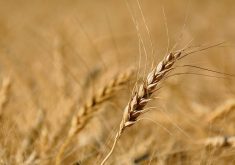With corn, soybeans and sunflowers still mostly in the field, and rain-soaked areas far behind, most regions of Manitoba are reported to have wrapped up their grain and oilseed harvests for the year.
In its final crop report for 2008, released Monday, Manitoba Agriculture, Food and Rural Initiatives reports that western, south-central and eastern Manitoba and the province’s southern Interlake are now mostly finished their grain and oilseed harvests. “Significant acreage” remains unharvested in the northern Interlake between Lake Manitoba and Lake Winnipeg.
Spring wheat crops have averaged 40 to 50 bushels per acre in the southwest, 50 in the northwest, above 45 in the central region west of the Red River, 44 in the east and 48 in the southern Interlake. The majority of spring wheat in most regions has graded around No. 2 CW, except in the southern Interlake where 50 per cent has graded No. 3 and 30 per cent No. 2.
Read Also

Senft to step down as CEO of Seeds Canada
Barry Senft, the founding CEO of the five-year-old Seeds Canada organization is stepping down as of January 2026.
Barley yields, meanwhile, averaged 75-90 bu./ac. in the southwest, 90 in the northwest, 55-100 in the central region, 78 in the east and 82 in the south Interlake. Barley graded about 20 per cent malt in the southwest, averaged No. 1 CW in the northwest, 30 per cent malt in the central region, up to 80 per cent feed in the southeast and 10 per cent malt, 50 per cent No. 1 CW in the southern Interlake.
Oats yields are averaging 75 to 90 bu./ac. in the southwest, 105 in the northwest, 105 in the central region, 115 in the east and 110 in the southern Interlake. Crop quality is at No. 2 and 3 CW in the southwest, No. 1 and 2 CW in the northwest, “generally very good” in the central region, mostly No. 1 or 2 CW in the east and 50 per cent No. 3 CW in the southern Interlake.
Canola crops in the southwest are averaging 40 to 45 bu./ac. and all grading No. 1; 50 bu./ac. and 80 per cent No. 1 in the northwest; 30-35 bu./ac. and mostly No. 1 in the central region; 43 nu./ac. and mostly No. 1 in the east; and 40 bu./ac. and No. 1 in the south Interlake.
Winter wheat, hay and forage
The number of acres seeded to winter wheat in Manitoba are expected to be average at best, with southwest acres having “dropped considerably,” northwest acres down, average in central regions although winter survival is a “concern” closer to the western banks of the Red due to heavy rains and ponding water; average in the southeast and below average further north; and below average from the previous two or three years in the Interlake, due to concerns with fusarium and sprouting.
Forage yields are about 30 to 50 per cent below normal in southwestern Manitoba, while in the northwest, good volumes of winter feed are offset by quality on the low side of average. Most farmers in central regions are expected to have “adequate” hay supplies, while in the east, feed supplies are adequate to above average and quality “average to excellent.” In the Interlake, winter feed supplies are short for producers on “marginal” soils, many hayfields were left unharvested due to wet weather and fall feeding is up by about 20 per cent over the previous average because producers can’t get at their hay or pasture.
Corn and soy
Soybean harvests range from halfway done to nearly complete in central areas, with yields averaging lower than last year at around 30 bu./ac. and some acres too wet yet to harvest. Soybeans in the south Interlake so far are averaging 41 bu./ac. and harvest is only 20 per cent complete further north. In the east, soybean yields are averaging 37 bu./ac. and grading No. 1 and 2.
Grain corn crops in central regions are mostly still too wet to harvest, though quality “looks good” and yields are expected in the 100 bu./ac. range. Continued rainfall in the east has left “significant acres” of corn and sunflowers yet to be harvested, and half the confectionary sunflower acres in the Interlake remain to be harvested, with yields estimated at about 1,000 to 1,200 pounds per acre.















